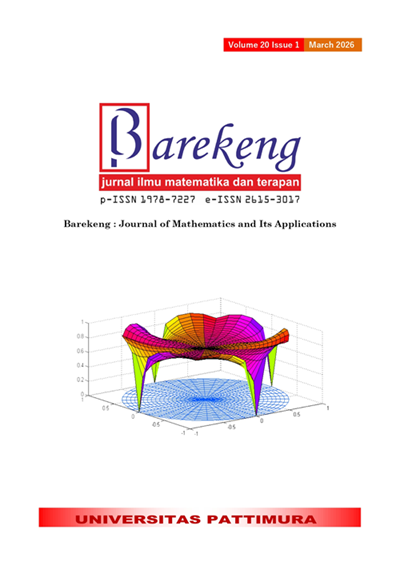ENHANCING STOCK PORTFOLIO PERFORMANCE USING MARKOV-SWITCHING MODELS AND CANDLESTICK PATTERNS FOR LONG-TERM INVESTMENT
Abstract
Islamic stocks in Indonesia face challenges in portfolio management due to the limited number of issuers and low diversification. The change in market regime from bullish to bearish makes the portfolio more vulnerable, especially since some investors do not understand the concept of portfolio and the importance of determining optimal asset weighting. In addition, the allocation strategy used tends to be static and minimizes the utilization of sharia-based technical analysis, making investment decisions less responsive to market dynamics. This study aims to compare the performance of two portfolio allocation algorithms, which integrate Markov-switching models and Heiken Ashi candlestick patterns for trend identification, respectively. The research method used is a quantitative approach with experimental techniques or computational simulations that aim to test the performance of the algorithm in producing optimal portfolio weights. The portfolio model developed is an extension of the Markowitz model with two different integration approaches, namely the Markov-switching model and the Heiken Ashi candlestick pattern. Portfolio weight optimization on each algorithm is performed using the Generalized Reduced Gradient (GRG) method. The Markov-switching model is a time series model used to identify changes in the average market regime. In contrast, the Heiken Ashi pattern is used to detect trend changes in stock price movements. The time series data used consists of daily stock prices of Islamic stocks listed in the Jakarta Islamic Index (JII) during the period January 2019 to August 2022, obtained from the Indonesia Stock Exchange (IDX). This study finds that the Markowitz model integrated with the Markov-switching model is able to effectively identify market regimes and improve efficiency in portfolio weight optimization. These findings provide valuable insights for Islamic equity investors in their risk mitigation efforts while helping to align expected returns with long-term investment strategies that are adaptive to bullish and bearish market conditions.
Downloads
References
P. Chandra, INVESTMENT ANALYSIS AND PORTFOLIO MANAGEMENT, 4th ed. New Delhi: Tata McGraw-Hill, 2012.
IDX, “PASAR SAHAM SYARIAH INDONESIA.” Accessed: Aug. 26, 2021. [Online]. Available: https://www.idx.co.id/idx-syariah/
DetikFinance, “CORONA MENGGILA, SAHAM FARMASI IKUT NGAMUK NAIK SAMPAI MENTOK!” Accessed: Aug. 27, 2021. [Online]. Available: https://finance.detik.com/bursa-dan-valas/d-5614436/corona-menggila-saham-farmasi-ikut-ngamuk-naik-sampai-mentok
Kompas, “MEROKET 3 KALI LIPAT LEBIH, INI RINCIAN HARGA SAHAM ANTM DALAM 3 BULAN.” Accessed: Aug. 27, 2021. [Online]. Available: https://money.kompas.com/read/2021/01/09/101124626/meroket-3-kali-lipat-lebih-ini-rincian-harga-saham-antm-dalam-3-bulan?page=all
Bareksa, “BERAPA LAMA IHSG PULIH PASCA KRISIS? INI DATA HISTORISNYA.” Accessed: Aug. 26, 2021. [Online]. Available: https://www.bareksa.com/berita/pasar-modal/2020-05-13/berapa-lama-ihsg-pulih-pasca-krisis-ini-data-historisnya
M. Ivanova and L. Dospatliev, “APPLICATION OF MARKOWITZ PORTFOLIO OPTIMIZATION ON BULGARIAN STOCK MARKET FROM 2013 TO 2016,” Int. J. Pure Apllied Math., vol. 117, no. 2, pp. 291–307, 2017, doi: https://doi.org/10.12732/ijpam.v117i2.5.
A. Gunawan, R. Fajriyah, M. A. Bimakasa, and S. N. Untari, “ANALYSIS OF PORTFOLIO FORMATION ON THE LQ45 STOCKS INDEX, USING THE MARKOWITZ AND SINGLE INDEX MODELS,” Barekeng J. Ilmu Mat. dan Terap., vol. 18, no. 4, pp. 2363–2374, Oct. 2024, doi: https://doi.org/10.30598/barekengvol18iss4pp2363-2374.
R. A. Wardani, S. Surono, and G. K. Wen, “OPTIMIZATION OF PORTFOLIO USING FUZZY SELECTION,” Barekeng J. Ilmu Mat. dan Terap., vol. 16, no. 4, pp. 1325–1336, Dec. 2022, doi: https://doi.org/10.30598/barekengvol16iss4pp1325-1336.
M. Shadabfar and L. Cheng, “PROBABILISTIC APPROACH FOR OPTIMAL PORTFOLIO SELECTION USING A HYBRID MONTE CARLO SIMULATION AND MARKOWITZ MODEL,” Alexandria Eng. J., vol. 59, no. 5, pp. 3381–3393, Oct. 2020, doi: https://doi.org/10.1016/j.aej.2020.05.006.
Y. Trichilli, M. B. Abbes, and A. Masmoudi, “ISLAMIC AND CONVENTIONAL PORTFOLIOS OPTIMIZATION UNDER INVESTOR SENTIMENT STATES: BAYESIAN VS MARKOWITZ PORTFOLIO ANALYSIS,” Res. Int. Bus. Financ., vol. 51, pp. 1–21, Jan. 2020, doi: https://doi.org/10.1016/j.ribaf.2019.101071.
F. Dominguez and B. J. Clempner, “MULTIPERIOD MEAN-VARIANCE CUSTOMER CONSTRAINED PORTFOLIO OPTIMIZATION FOR FINITE DISCRETE-TIME MARKOV CHAINS,” Econ. Comput. Econ. Cybern. Stud. Res., vol. 53, no. 1, pp. 39–56, Mar. 2019, doi: https://doi.org/10.24818/18423264/53.1.19.03.
I. Seidl, “MARKOWITZ VERSUS REGIME SWITCHING: AN EMPIRICAL APPROACH,” Rev. Financ. Bank., vol. 4, no. 1, pp. 33–43, 2012, [Online]. Available: https://ideas.repec.org/a/rfb/journl/v04y2012i1p033-043.html
D. Nurdiansyah and A. Y. Kartini, “ALGORITMA GENERALIZED REDUCED GRADIENT BERBASIS MARKOV-SWITCHING MODEL UNTUK OPTIMISASI PORTOFOLIO SAHAM PERBANKAN DI INDONESIA,” Media Bina Ilm., vol. 14, no. 2, pp. 2095–2108, 2019, doi: https://doi.org/10.33758/mbi.v14i2.369.
H. Qiu and F. Liu, “CANDLESTICK ANALYSIS IN FORECASTING U.S. STOCK MARKET: ARE THEY INFORMATIVE AND EFFECTIVE,” in 2019 IEEE 4th International Conference on Big Data Analytics, IEEE, Mar. 2019, pp. 325–328. doi: https://doi.org/10.1109/ICBDA.2019.8713248.
A. Heinz, M. Jamaloodeen, A. Saxena, and L. Pollacia, “BULLISH AND BEARISH ENGULFING JAPANESE CANDLESTICK PATTERNS: A STATISTICAL ANALYSIS ON THE S&P 500 INDEX,” Q. Rev. Econ. Financ., vol. 79, pp. 1–57, Feb. 2021, doi: https://doi.org/10.1016/j.qref.2020.06.006.
R. S. Trivedi, “TECHNICAL ANALYSIS STRATEGIES: DEVELOPMENT OF HEIKEN ASHI STOCHASTIC,” MPRA Pap., no. 90439, 2018, [Online]. Available: https://mpra.ub.uni-muenchen.de/89594/
S. Benninga, FINANCIAL MODELING, 4th ed. London: The MIT Press, 2014.
A. Ravindran, K. M. Ragsdell, and G. V. Reklaitis, ENGINEERING OPTIMIZATION: METHODS AND APPLICATIONS, 2nd ed. New Jersey: John Wiley & Sons, 2006.doi: https://doi.org/10.1002/9780470117811
D. Nurdiansyah and A. Sulistiawan, DASAR PEMROGRAMAN KOMPUTER DENGAN OPEN SOURCE SOFTWARE R (UNTUK BIDANG SAINS DAN TEKNOLOGI). Banten: CV. AA. RIZKY, 2023.
D. Nurdiansyah and K. Wafa, “PENERAPAN MODEL EXPONENTIAL SMOOTHING BERBASIS METODE EVOLUTIONARY PADA KASUS COVID-19 DAN DBD DI BOJONEGORO,” J. Kesehat. Vokasional, vol. 6, no. 3, pp. 174–181, Aug. 2021, doi: https://doi.org/10.22146/jkesvo.65937.
Copyright (c) 2025 Denny Nurdiansyah, Agus Sulistiawan

This work is licensed under a Creative Commons Attribution-ShareAlike 4.0 International License.
Authors who publish with this Journal agree to the following terms:
- Author retain copyright and grant the journal right of first publication with the work simultaneously licensed under a creative commons attribution license that allow others to share the work within an acknowledgement of the work’s authorship and initial publication of this journal.
- Authors are able to enter into separate, additional contractual arrangement for the non-exclusive distribution of the journal’s published version of the work (e.g. acknowledgement of its initial publication in this journal).
- Authors are permitted and encouraged to post their work online (e.g. in institutional repositories or on their websites) prior to and during the submission process, as it can lead to productive exchanges, as well as earlier and greater citation of published works.






1.gif)



